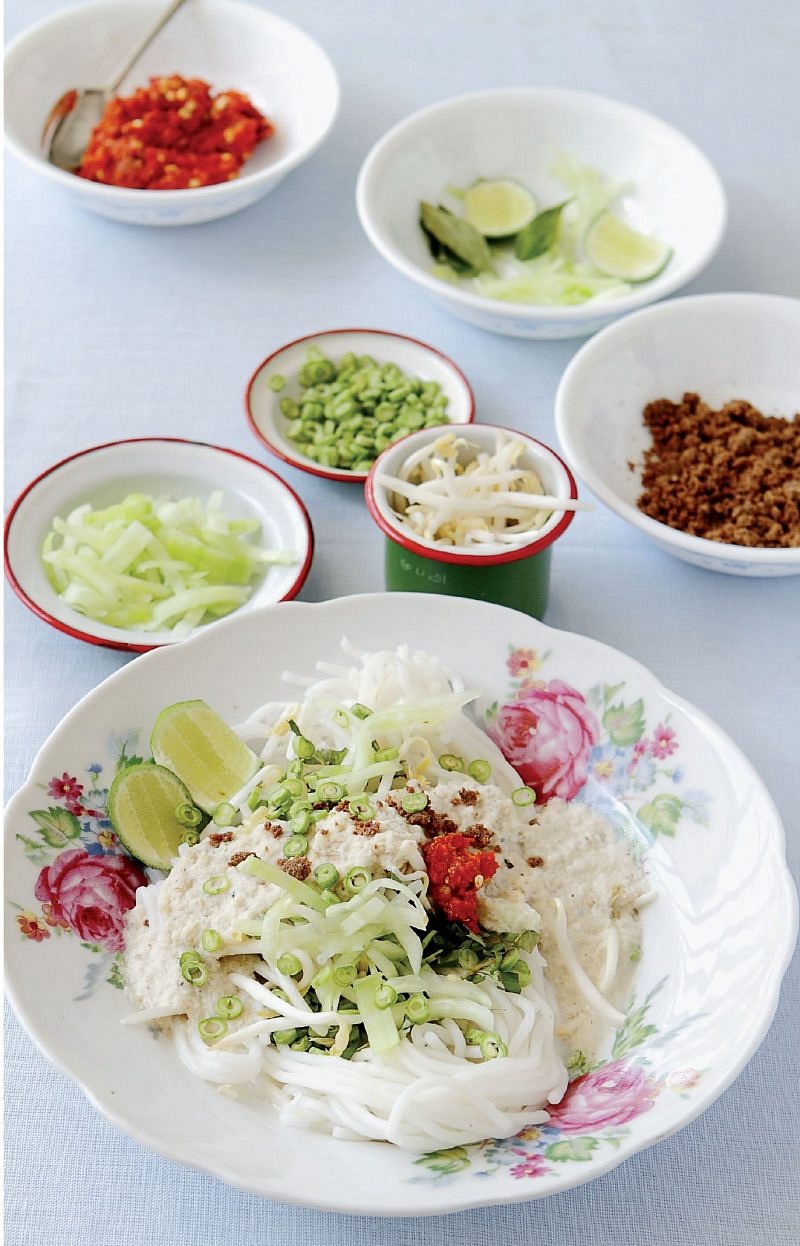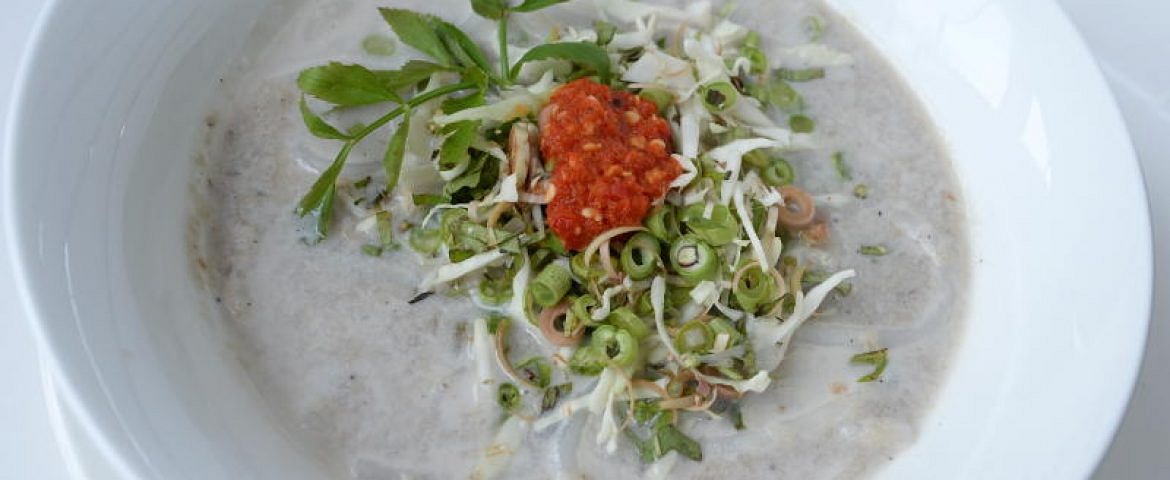The many faces of Malaysia’s laksa – Part 2
Travel to Malaysia’s East Coast and Sarawak for the noodle dish; also check out the recipes for laksa kuah putih and laksa kuah merah.

(THE STAR/ASIA NEWS NETWORK) - On Malaysia's East Coast, a tale of two laksas is told.
Skirting the coasts of Kelantan, Terengganu and Pahang - and finding their way to Johor on occasion - these are the Rose Red and Snow White of a very different (and delicious) fairy tale.
Siblings, they are laced with the fish and coconut milk that you would expect from their lands of origin, but manifest quite differently.
The kuah putih, or white gravy, sees its noodles in a simpler, cleaner, milder gravy. It is particularly popular in Kelantan, where it is synonymous with the eponymous Laksa Kelantan.
In the state, its purity of colour is maintained by the common use of tenggiri, with its marble-pale flesh, in homes. If you buy it from a street vendor though, you are likely to find the cheaper ikan kembung instead.
Laksa kuah putih gives the humble white pepper a dominant role in a way that few dishes do - it is the predominant flavour in the thick coconut milk gravy, with a supporting cast of shallots, ginger and lemongrass. A squeeze of lime freshens the gravy after its slow cooking treatment.
It is a gravy that is similar to the one that bathes laksam; what differentiates them is the thick, rustic rice rolls that you will find in laksam.

Both dishes are finished with a generous handful of vegetables and fragrant herbs - finely sliced long beans, bean sprouts, cucumber, with Thai (daun selasih) or holy (daun kemangi) basil and the ubiquitous laksa leaf (daun kesum).
"Terengganu is the only state where both laksa kuah putih and kuah merah - which we also call 'kuah masak' - are offered alongside for choice in the markets," To' Puan Rosita Abdullah, author of Kulit Manis: A Taste Of Terengganu's Heritage, told Flavours magazine in a 2012 article.
"The Terengganu kuah masak uses less fish, unlike in Pahang, where the gravy is thicker. The laksa paste can easily be bought in the market and fish used could be tenggiri, kembung or selayang.
"The fresh green topping can include shredded brinjal and daun jambu golok (cashew nut shoots)."
Because of its comparative mildness, you will find laksa kuah putih eaten for breakfast more often.
Also based on coconut milk, kuah merah has extra fish power - in addition to the fresh ikan kembung or tenggiri it is usually made with, the deeper, more layered flavour of salted fish is also often discernible.
In addition to the other toppings, the intensely orange-yolked salted duck egg can also be a topping, as can daun kaduk (wild pepper leaf).
"People usually make one or the other," said Datin Munira Salinger, in Red & White Laksas (Flavours, 2012).
In the Pahang-born former teacher's autobiography, My Story, you will find illustrations of her long-held enthusiasm for researching the history and culture of Malay food in particular, with some of her favourite recipes.
She says that the kuah merah is a grander dish with more planning and prep involved and so is usually saved for more elaborate functions rather than one-dish meals at home.
"It is something that one gives to family members living nearby - often sent in a tiffin carrier as a gift - and one would provide enough to feed the whole family," she said.
Hopping across the South China Sea, you will find Sarawak Laksa - a dish so fabulously rich that it sees foodies' ears pricking up all over the country at the mere mention.

While its home state boasts the most proliferation, you will also find it in Sabah and in neighbouring Brunei.
"Without a doubt, the Sarawak variety is my favourite laksa," said Basira Yeusuff, chef-owner of Agak-Agak in APW Bangsar.
"I was in Sarawak a few years ago and friends had given me a list of laksa joints to check out - I was smitten. I'd had KL's take on the dish and preferred it to other varieties already, but I found the way the locals made the broth was slightly different.
"And most importantly, they used baby coriander cress instead of mature coriander leaves."
The fact that Sarawak laksa is made from a paste with a multitude of ingredients that also remains a jealously guarded secret only adds to its mystery-wreathed allure.
Often, when you find the dish on a menu in Peninsular Malaysia, it has been made with the paste specially ordered from Sarawak; a few adventurous chefs do attempt to replicate it solely by taste, but Sarawak laksa is unique in its common status as being more often made from a paste made and imported from its home state. This is so even when the dish is cooked at home.
The fiery, crimson gravy is laced with spices such as cumin, star anise, fennel, cardamom, cloves, nutmeg, white pepper and coriander, and includes a chunk of belacan along with the ginger, chillies, lemongrass, galangal and shallots. Both chicken and prawn stocks are used and there are also roasted, ground peanuts, sesame seeds and candlenuts in there.
That explains its distinctive, delicious complexity and richness, but the key is in getting the ratio of every ingredient right.
Its origins, like those of many local dishes, are anchored more in lore than stone.

There is a legend that in 1945, Goh Lik Teck, a Teochew migrant from Guangzhou, China, started selling a simpler version of the dish - with just six ingredients - in Kuching's Carpenter Street.
Another story has the laksa emerging from the Chinese and Malay cultural collusion, rather than just one noodle-seller.
In the 1960s, Goh's family started making and selling the paste to other vendors; around the same time, businessman Tan Yong Him started selling the paste commercially under the Swallow brand, and other bird-oriented brands soon followed suit.
Laksa paste and intense gravy aside, the other building blocks of Sarawak laksa are rice vermicelli, shreds of chicken and omelette, prawns and fresh coriander leaves. A spoonful of piquant sambal and lime halves are always served on the side.
And that is the dish that Anthony Bourdain tweeted was the "breakfast of the gods" in 2015, when he revisited Kuching's famous Choon Hui Cafe for CNN's Parts Unknown; it was his second visit to the very same coffee shop, after his 2005 stop there for the Travel Channel's No Reservations.
The stories of laksa are legion - in keeping with the dish itself. But enough reading about this amazing, versatile dish for now - it is time to get into the kitchen and turn your hand to the grinding and tumis-ing of herbs and spices.
Try The Star's recipes for the laksas with kuah putih and kuah merah - they are from Datin Munira Salinger and were first published in the June 2012 issue of Flavours magazine.

MALAYSIAN LAKSA RECIPE: LAKSA KUAH PUTIH
INGREDIENTS
Thick rice noodles (laksa) or spaghetti
Kuah putih
200g flaked fish (tenggiri, kembung or selayang, steamed, deboned and flaked)
100g shallot paste
30g ginger paste
3 pieces asam gelugor (garcinia atroviridis)
1 litre fresh coconut milk (from 2 grated coconuts)
1 tbsp pepper
1 tbsp salt
Sugar, to taste
Sambal belacan
8 fresh red chillies
5g belacan (dried shrimp paste), toasted
Lime juice, to taste
Toppings
Bean sprouts
Cucumber, peeled, cored and shredded
Long beans (raw), finely sliced
Laksa leaves (daun kesum), finely sliced
Turmeric leaves (daun kunyit), finely sliced
Onion, finely sliced
Hard-boiled eggs, halved or quartered
METHOD
Kuah putih
In a pot, bring the fish, pastes, asam, and coconut milk to boil on low to medium heat, stirring from time to time. Season to taste with pepper, salt and sugar.
The gravy should be barely salty and sour, as the condiments of sambal belacan and lime are added at the table for adjusting to individual taste.
Sambal
Pound the chillies and belacan together, and season to taste with lime juice.
To serve
Place a serving of laksa noodles in a soup plate and add toppings. Ladle the kuah over and garnish with a wedge of lime and teaspoon of sambal.

MALAYSIAN LAKSA RECIPE: LAKSA KUAH MERAH
INGREDIENTS
Thick rice noodles (laksa) or spaghetti
Nyior magai
150g freshly grated white coconut meat
50 to 100ml water
Spice paste
50 dried chillies, soaked in hot water (or ½ cup cili boh)
125g shallots, peeled (or ½ cup shallot paste)
20g ginger, peeled (or ½ tbsp ginger paste)
15 garlic, peeled (or ½ tbsp garlic paste)
40g rendang spice mix (from Adabi, Mak Siti, etc.)
150ml cooking oil
1 litre coconut milk (from 2 coconuts)
400g (3 cups) fish flakes (from 600g ikan kembung that has been steamed and deboned)
60g (½ cup) dried salted fish (preferably kurau), soaked in hot water, then pounded
60g (½ cup) dried prawns, soaked in hot water, then pounded
3 pieces asam gelugor (garcinia atroviridis) or 2 tbsp tamarind pulp
60g peeled galangal (lengkuas), crushed
8 stalks lemongrass, crushed
½ cup toasted grated coconut (kerisik), ground finely
½ cup nyior magai
Salt and sugar, to taste
Sambal belacan
8 fresh red chillies
5g belacan (dried shrimp paste), toasted
Lime juice, to taste
Toppings
Bean sprouts
Cucumber, peeled, cored and shredded
Long beans (raw), finely sliced
Laksa leaves (daun kesum), finely sliced
Turmeric leaves (daun kunyit), finely sliced
Onion, finely sliced
Hard-boiled eggs, halved or quartered
METHOD
Nyior magai
In a clean wok over low heat, fry the grated coconut lightly, stirring all the time, until fragrant but not coloured. Transfer to an electric blender and blitz with a little water. Set aside.
Spice paste
Blend the chillies, shallots, ginger and garlic to a paste and mix with the rendang spices.
Kuah Merah
Heat the oil in a pot. When hot, add the spice paste and fry on medium to low heat until aromatic, for about 8 minutes.
Add the coconut milk and stir to mix well. Add the flaked fish, salted fish, dried prawns, asam gelugor, galangal, lemongrass, kerisik and nyior magai along with 3 cups of hot water before seasoning to taste with salt and sugar.
When it boils, lower heat down to a simmer. Keep cooking on low heat until oil surfaces, stirring from time to time.
Add more hot water, about 1 to 2 cups, as the gravy thickens.
Sambal
Pound the chillies and belacan together and season to taste with lime juice.
To serve
Place a serving of laksa noodles in a soup plate and add toppings. Ladle the kuah over and garnish with a wedge of lime and teaspoon of sambal.
Join ST's Telegram channel and get the latest breaking news delivered to you.
